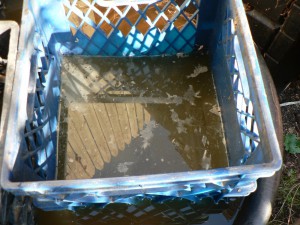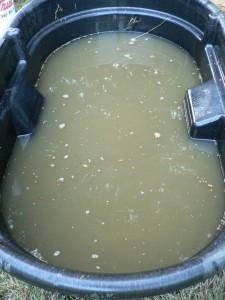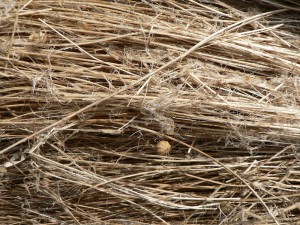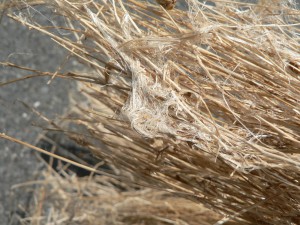Summer is rushing along, tipping noticeably toward fall. The Concord grapes are ripe and fragrant, waiting, camouflaged, to surprise passers by. “Mmm, what’s that smell? Oh, grapes!” But right behind our apartment it currently smells like a retting tank and a woad vat. It’s not “Mmm,” it’s somewhere between “Uh…?” and “Ugh!”
Here in Amherst I am happy to report that we have been having glorious weather for the past week. Flax retting, a modest amount of flax processing, dyeing, making salsa (not really in the scope of this blog, I know) are all continuing apace.
For several weeks, the majority of this year’s flax has been drying on the hay tedder in the tractor shed over at Amethyst Farm (thanks to the generosity of the Brennans). To make room to move this year’s crop gradually into the back of our car (which serves as our shed) I had to ret last year’s flax. I posted about that earlier. That is now all complete.
I retted the first batch (from our community garden) in the 50 gallon tank. I didn’t change the water at all during the retting period (from July 27th to August 2nd–six days). Here’s how the water looked when it was ready to pull out.
Note the yellowish grey film on top.
At the flax demonstration in Gilmanton, NH, Gina Gerhard had given Faith and me a tip on how to check when your retting is complete: the fiber should pull away from the stem with absolutely no resistance.
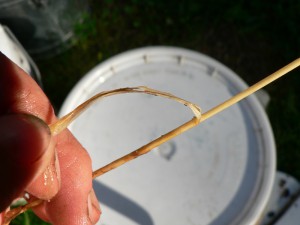 It seemed done. Then I rinsed off the stinky film and presumably the majority of the active bacteria, before hanging up the bundles to dry. Here are the bundles getting rinsed and the murky rinse water:
It seemed done. Then I rinsed off the stinky film and presumably the majority of the active bacteria, before hanging up the bundles to dry. Here are the bundles getting rinsed and the murky rinse water:
Quite a lot of broken fiber rinsed off, which hadn’t really happened to me before. This was puzzling. When it was all dry, I was concerned about all the white fuzzy fibers that had loosened and formed little clumps.
This little silvery clump in the photo above will be waste. I don’t think it will even be tow because it’s so compacted. Maybe it could be used for paper. So, at seeing this, I panicked that it was over-retted, and pulled out the second batch from the 100 gallon tank (grown at Bramble Hill) after only 4 days. But once I rinsed and dried that, it was clear that it was under-retted. The woody stems did not snap and the fibers pulled off with a waxy sort of coating. So I put the Bramble Hill flax back into a tank with the first of this year’s flax to ret, and pulled it out after 24 hours. It seems OK, but I won’t really know until I try to brake it.
Here’s all of last year’s flax retted and dried.
I now know that a good portion of what I retted in the past was under-retted, but I broke most of it in the fall so I can’t re-ret it at this point. I have been trying to process it anyway, but it is very difficult to get off the woody bits (shives, boon, chaff, needle-like splinters, whatever you want to call it) and the fibers have a waxy, wiry feeling. So, now I have some (presumably) over-retted to compare with my under-retted. Considering the fact that at one point I wasn’t even planning to save my 2011 fiber, since it was very mature when I harvested it, I try to view this whole thing as a learning experience.

